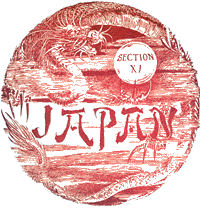|
Brinkley, Frank (Captain):
Japan, Described and Illustrated by the Japanese, Written By Eminent Japanese Authorities and Scholars, Boston and Tokyo, J.B. Millet Company, 1897~8, 15 section (volume) set, 260 illustrations (including 30 albumen hand colored and 15 color collotypes (by K. Ogawa) of flowers), 382 pp. This version is not given an edition name nor are quantity printed stated. The set comes in 15 separate sections (volumes) which are Folio size (12 1/2 x 15 3/4 in) with stiff paper wraps (as before binding). The 382 pages are uncut double pages (i.e. back blank) and there are inserts cautioning not to cut the pages. The plates, (60 separate pages) are not numbered or included in the page count.
This work is a profusely illustrated view of the Japanese people and Japan at large. It is a comprehensive view (written and pictorial) of that culture at the close of the 19th century before the results of western influence were manifest. The illustrations present well known as well as more obscure places, daily activities, and people engaged in the toil of trades, farming, commerce, leisure time activities and household activities. The set is organized into specific topics, covering Japanese festivals, history, customs, medieval Japan etc. Each section has narrative and comprehensive complementary art/illustrations. There are no table of contents or listing of the photographs as found in the hardbound named editions.
The accompanying illustrations/art are, perhaps, the key and distinguishing feature of the Brinkley books. Each section begins with a beautiful full plate color collotype photograph of a flower (photographed by K. Ogawa) and contains two full plate (2) hand colored albumen photographs of people, everyday activities or scenic places. There are numerous black and white photo illustrations in the text that show the interiors of homes, art works, scenery, activities of daily life, and a host of other views on Japan in the late 19th century. While not credited in the text, the photos are believed to be by Kozaburo Tamamura with colored added in his studio (sometimes referred to as a picture factory) by a large (100+) staff of colorists. Each section also contains a full page mono-color plate reproducing patterns.
This 15 section set has the same text as in the standard 10 volume sets that are found with cloth covers. It contains the same handcolored albumen photographs (30) and the same in text photographs. This 15 section set does contain 5 additional Ogawa color collotypes of flowers not found in the 10 volume cloth bound sets. The normal length of each volume in the 15 section set is 25 pages per set where the average length per volume of the 10 volume set is 38 pages.
Covers (Paper Wraps).
Title Page.
These books have four basic types of illustrations.
- Color collotype frontispieces (flowers by Ogawa) printed on thick mat and protected by tissue guard generally 7 1/2 x 11 in (image area) with tinted border all around of 1/4 in. All in vertical format (1 oval shape, others rectangular).
- Albumen photographs which have been hand colored (8 x 10 in). These are tipped in on a thick backing mat. Each albumem print is protected by a tissue guard with title and explanation. There is no writing/titling on the actual photographs. These photographs are in both horizontal and vertical format.
- Text illustrations. Black and white half-tone photographs (generally 3 1/2+ x 5+ in) inserted in the text in both vertical and horizontal format.
- Mono-color (generally red) reproductions of stencils used in printing fabrics.
Quantities.
- 15 Color Collotype Frontispieces (Flowers)
- 30 Albumen Photographs (Hand Colored)
- 200 Text Illustrations
- 15 Mono-color Reproductions of Prints/Patterns
260 - Total
I have also seen this 15 section set listed with 10 hand colored full page plates of art work. I have not personally reviewed such a set but it would appear to be a deluxe edition of the set.
|
|
Normally this 15 section set is found unbound in the original stiff cardboard wraps. However, I have seen it consolidated into a 10 volume bound set. This bound set was designated the "Tokyo Edition" and limited to 500 numbered copies There is no title page as found in the 10 volume sets, just the introductory section page as seen in the 15 section set. Each volume has 3 handcolored albumen photographs, a reproduction of a screen pattern and 1 or 2 Kazumasa Ogawa flower collotypes.
Section I. Japan - I. The Empire, Its Size, Buildings, Cities and Scenery. (Pages 1~22)
Illustrations:
- Bronze Daibutsu at Koyasan (in Intoduction)
- Frontispiece. Color - Flowers, Orchids with tissue guard
- A Group of Nobles and Dignitaries
- A Winter Scene in Yokohama
- A Street in Enoshima
- Mount Fuji as Seen From Kashiwabara- hand colored albumen print 8"x10 ˝"-
- The Nagara-gwa Bridge after The Great Earthquake in 1891
- An Informal Visit
- Lantern Makers
- A Fair Student
- Print. Koi Fish
- Foot Bridge Across the Miyanoshita River
- Coopers at work
- Kago Bearers
- Fuji-ya at Miyanoshita
- The Bronze Buddha at Kamakura- hand colored albumen print 8"x10 ˝" w tissue guard
- A Buddhist Funeral
- A Dealer in Inlaid Woodenware
Section II -- The Early Japanese and Their History. (Pages 23~48)
Illustrations:
- Frontispiece. Color - Flowers with tissue guard
- Tea House "Ebisuya" Enoshima
- Painting (untitled) of Mt Fuji
- Men-Daki or "Female Fall" at Kobe
- Jinrikishas- hand colored albumen print 8"x10 ˝" with tissue guard
- Giant Pine Tree at Karasaki
- An Actor of To-day
- A Group of naval officers
- Print. Fans
- A Japanese Wrestler
- Geisha Playing Samisen
- Garden of Lord Horita in Tokyo
- Street Vendor of Flowers - hand colored albumen print 8"x10 ˝" with tissue guard
- A Japanese Tea House
- Bird's Eye View of Yokosuka
- Kiyomozo Temple, Kyoto
- Geisha Giving Entertainment
- Torii at Miyajima
Section III. The Early Japanese and Their History (continued). The Story of the Forty-Seven Ronins. (Pages 49~74)
Illustrations:
- Frontispiece. Color - Flowers with tissue guard
- Kiyomizu Temple, Kyoto
- A Cave Dweller at Dogashima
- Fishermaidens - hand colored albumen print 8"x10 ˝" with tissue guard
- Custom House at Yokohama
- Japanese Waterfall
- Dancing Girls
- Print. Flowers - Cherry Blossoms
- A Samurai
- Geisha Playing Koto
- Tub Maker
- Bridge at Arashiyama near Kyoto - hand colored albumen print 8"x10 ˝" with tissue guard
- A Japanese Cemetry
- Vender of Brooms
- An Afternoon Nap
- Playing Hop Scotch
Section IV. Establishment of the Tokugawa Dynasty and Japan's Relations with the Orient in the Early Ages of the Christian Era. (Pages 75~100)
Illustrations:
- Frontispiece. Color - Flowers, Lilies with tissue guard
- Interior Gallery of the Chion-in Temple at Kyoto
- A Mountain Chair
- A Change of Domicile
- Sacred Bridge at Nikko - hand colored albumen print 8"x10 ˝" with tissue guard
- A Country Road
- Stone Steps at Nikko
- Dancing Girls
- Print. Geese and Flowers
- A Family Picnic
- Japanese Carpenters at Work
- View from Gallery of Hotel Yaami at Kyoto
- Washing Kimonos
- Interior of Nobleman's Palace - hand colored albumen print 8"x10 ˝" with tissue guard
- A Family Group
- Ploughing a Rice Field
- (untitled) Painting
Section V. Establishment of the Tokugawa Dynasty and Japan's Relations with the Orient in the Early Ages of the Christian Era (Continued). Mediaeval Japan. (Pages 101~126)
Illustrations:
- Frontispiece. Color - Flowers, Lilies with tissue guard
- Baskets and Wooden-Ware for Sale Here
- Boys Playing Kotoro
- A Tea-House Restaurant in Kyoto - hand colored albumen print 8"x10 ˝" with tissue guard
- Japanese actors
- Tea House on the Bluff, Yokohama
- Kago bearers
- Print. Pine cones
- Fishermen Launching Their Boat
- A Japanese Interior
- Torii in Temple Grounds
- A Group of Boys and Girls- hand colored albumen print 8"x10 ˝" with tissue guard
- Nagoya Castle
- Bridge Wrecked by Earthquake
- Imperial Hotel in Tokyo
- Amma-san, or Blind Shampooer
Section VI. Mediaeval Japan (Continued). Yoshitsune, Genghis and the Mongol Invasion (Pages 127~152)
Illustrations:
- Frontispiece. Color - Flowers with tissue guard
- A Street in the Foreign Settlement of Yokohama
- Bridge over the Sumida River, Tokyo
- Buddhist priests
- Grocery and Fruit Shop - hand colored albumen print 8"x10 ˝" with tissue guard
- Blacksmiths and Wheelwrights
- A Family Group
- Dancing Girls
- Courtyard of Grand Hotel at Yokohama
- Print. Starks
- Negishi at Yokohama
- Tattooed Man
- Playing Go
- A Geisha - hand colored albumen print 8"x10 ˝" with tissue guard
- Mendicant Priests
- A Typical Street Scene
- A Japanese Samurai
- Grocery shop
Section VII. Yoshitsune, Genghis and the Mongol Invasion (Continued). Creeds and Castles. (Pages 153~178)
Illustrations:
- Frontispiece. Color - Flowers with tissue guard
- A Japanese barber
- Winter Scene in Yokohama
- Bamboo Grove Near Kyoto - hand colored albumen print 8"x10 ˝" with tissue guard
- Threshing Grain
- Spinning Cotton
- Room in Tea House at Yumoto
- Eating Macaroni
- Print. Bamboo
- Toy makers
- A Curbstone Merchant
- Japanese Types
- Wine Shop
- Wrestlers - hand colored albumen print 8"x10 ˝" with tissue guard
- A Vendor of Amisake
- Honcho Dori, Yokohama
- Exterior Gallery of Japanese Temple
Section VIII. Creeds and Castles (Continued). Religion & Rites (Pages 179~204)
Illustrations:
- Frontispiece. Color - Flower with tissue guard
- Railway station at Yokohma
- Miogi Mountain
- Boat bridge at Nakasendo
- Niomon Iyemitsu Temple at Nikko
- Teaching Songs - hand colored albumen print 8"x10 ˝"-Geisha instruction
- Shotoyen Garden, Sakawa Village, Tokaido
- Hafuya Hotel, Hakone
- Wayside resting place
- Print. Cherry Blossoms
- A Lotus Garden
- Ox Cart
- Tea-pickers - hand colored albumen print 8"x10 ˝" with tissue guard
- Creek-Side Yokohama
- Sea Cave at Enoshima
- Futu-Ara Temple, Nikko
- Carpenters at Work
Section IX. Religion & Rites. Superstitions and Divination. (Pages 205~230)
Illustrations:
- Frontispiece. Color - Flowers with tissue guard
- Stone Torii, Suwa Temple, Nagasaki
- Oji Tea House, Tokyo
- Preparing a Dinner
- Weighing Tea
- Tattooed Postman - hand colored albumen print 8"x10 ˝" with tissue guard
- Samurai in Armor
- Wrecked by an Earthquake
- Kiga Road near Miyanoshita
- Nakajima, Nagasaki
- Print. Mice
- Peasant Woman Carrying Fagots
- Sanmai Bashi tea house
- Wisteria at Kameido Temple, Tokyo- hand colored albumen print 8"x10 ˝" with tissue guard
- Learning to Write
- En Deshabille
- Fencing
- Japanese Types (three girls)
Section X. Festivals. Observances and Pastimes. (Pages 231~256)
Illustrations:
- Frontispiece. Color - Flowers with tissue guard
- A Geisha Playing Samisen
- Winter Costume
- The Village Water-Wheel
- Cottage Garden at Kamakura- hand colored albumen print 8"x10 ˝" with tissue guard
- Graveyard Near Kyoto
- Temple Gate, Shiba Park, Tokyo
- Bronze Lantern from Korea and Candelabrum from Holland
- Print. Leaves
- Fujiyama from Numigawa
- Interior of One of the Largest Temples, Nikko
- Tea-House on the Lake at Nara Park
- The One Hundred Steps at Yokohama - hand colored albumen print 8"x10 ˝" "Teahouse Occupied by Commodore Perry in 1853-4" with tissue guard
- Village of Oji, One of Suburbs of Tokyo
- Making a Toilet
- Stone Basin and Bronze Dragon at Mitake
- Big Bronze Bell at Kyoto
- Pine Grove Near the Sea-Shore
Section XI. Observances and Pastimes. (Pages 257~282)
Illustrations:
- Frontispiece. Color - Flowers with tissue guard
- Buddhist Priest
- Garden at Daimichido
- Waitress in Tea-House
- A Koto Player - hand colored albumen print 8"x10 ˝" with tissue guard
- A Picturesque Stone Bridge
- Side View of the Bronze Buddha at Kamakura
- A Beach at Tomioka
- Print. Cherry Blossoms
- Out-of-Door Music, Nara
- Shuzenji Village, Province of Idzu
- Geishas of the Younger Class
- Tonosawa in the Hakoke District Near Yumoto
- The Nikko Road - hand colored albumen print 8"x10 ˝" with tissue guard
- Private Residence on the Bluff at Yokohama
- The Great Bronze Bell at Nara
Section XII. Observances and Pastimes (Continued). Japan's Commercial and Political Intercourse with Foreign Countries. (Pages 283~308)
Illustrations:
- Frontispiece. Color - Flowers with tissue guard
- Dancing girls
- Shinto Priests Soliciting Alms
- Actors in the Ancient Dance Kagura
- Writing a Letter - hand colored albumen print 8"x10 ˝" with tissue guard
- An Orchestra for Geisha Dancing
- Interior of Asakusa temple, Tokyo
- A Wrestling Match
- Steps and Gate Leading to the Temple Inside the Main Entrance at Shiba Park, Tokyo
- Print. Bamboo
- An "Ono" Dancer in Costume
- Steet Scene in Yokohama
- Village Stream in Midsummer
- A Funeral Procession - hand colored albumen print 8"x10 ˝" with tissue guard
- Haruna Lake, above Ikao
- Every-Day Costumes of the Cetter Class
- Bronze Gate and Tomb, Shiba Park, Tokyo
- Funeral Service in a Shinto Temple
- Method of Dressing the Hair (for men) Before the Revolution of 1867
Section XIII. Japan's Commercial and Political Intercourse with Foreign Countries (Continued). (Pages 309~334)
Illustrations:
- Frontispiece. Color - Flowers with tissue guard
- Pounding Rice,
- Rice Cutting in the Fields Near Omori, Between Tokyo and Yokohama
- Teaching Young Girls to Write
- Receiving a guest-hand colored albumen print 8"x10 ˝" with tissue guard
- House-Cleaning,
- A Street in the Yoshiwara, Tokyo
- Wooden Bridge at Iwakuni
- A Lunch Party
- Print. Leaves
- Result of an Earthquake at Nagoya
- Hakone Lake and Village, with Emperor's Palace in the Distance
- Fujiya Hotel at Miyanoshita
- Arranging Flowers - hand-colored albumen print 8"x10 ˝" with tissue guard
- Street Singer
- A Farmer and Wife Weighing and Reeling Silk
- Flooding an Iris Garden (Near Tokyo) by Man Power
Section XIV. Japan's Commercial and Political Intercourse with Foreign Countries (Continued). The Attitude of Japan Toward Foreign Residents - Japanese Finance. The Attitude of Japan Toward Foreign Residents-Japanese Finance (Continued). Modern Japan in Brief. (Pages 335~360)
Illustrations:
- Frontispiece. Color - Flowers with tissue guard
- Bund at Kobe
- Hotel Metropole, Tsukiji, Tokyo
- Lunch Stand in a Public Park
- Village of Kiga near Miyonoshita
- Workmen's Holiday - hand-colored albumen print 8"x10 ˝" with tissue guard
- Group of Children
- Gathering Coccoons
- Reeling Silk into Large Skeins for the Market
- Print. Starks/crames
- Reeling Silk
- Sorting and Sifting Tea Outside the Go-Down (Storehouse)
- Great Bell at Chion-In Temple, Kyoto - hand-colored albumen print 8"x10 ˝" with tissue guard
- Stone Bridge in the Mito Garden, Tokyo
- Mortuary Bronze Lanterns in Temple Enclosure at Shiba Park, Tokyo
- Water-Carrier Filling his Pails at a Well in Side Street in Kyoto
- Temple Bell at Kawasaki
- Rocks and Shore below Kamakura
- Ceremony on Arrival and Departure of a Guest
Section XV. Modern Japan in Brief (Continued). (Pages 361~382)
Illustrations:
- Frontispiece. Color - Flowers with tissue guard
- Small Summer Hotel at Kanazawa
- Rest-House on Noge Hill, Above Yokohama in Cherry-Blossom Time
- Fujiyama from Kamado Near Gotenba, Late in the Fall
- Playing Blindman's Buff in Side Street Leading to the Moat in Tokyo
- Bronze Horse at Suwa Temple, Nagasaki
- Theatrical Performance - hand-colored albumen print 8"x10 ˝" with tissue guard
- Graves of the Forty-Seven Ronins
- Stone Arch on Mitake-Yama, Usually Called Ontake
- Rear of an Ordinary Dwelling
- Print. Flowers (Red)
- On the Beach at Enoshima, at Low Tide
- View of Katsura River Near Arashiyama
- Type of the Geisha Class
- Mangwanji Temple at Nikko - hand-colored albumen print 8"x10 ˝" with tissue guard
- The Hot Springs at Atami, One of the Most Popular Watering-Places
|
|
1897~8 - 15 Section (Paper Wraps) Set
Covers
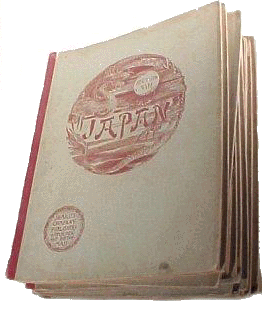
Title Page
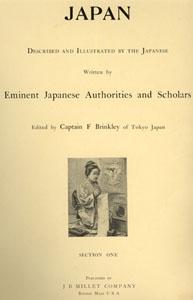
Color Flower Collotypes by Ogawa
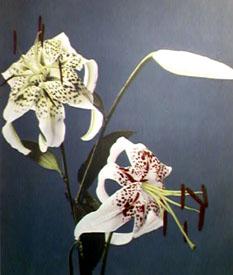
Albumen Photograph, Hand Colored
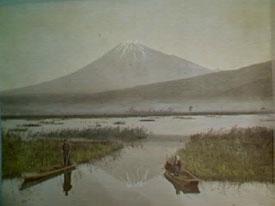
* Albumen Photographs. Albumen prints were introduced around 1850 by the French photographer Louis-Désiré Blanquart-Evrard. The albumen paper was prepared by first floating a sheet of fine quality paper on a solution of albumen (hen egg white) mixed with a salt. This process was sometimes repeated several times. When dried, the albumem coated paper was floated on a silver nitrate solution. The silver nitrate combined with the salt to form light-sensitive silver chloride in the albumen binder layer. The paper can then be exposed to light in direct contact with the negative. Light energy converts the silver halide to metallic silver. The resulting silver-based image is fixed with an aqueous solution of sodium thiosulphate and gold-toned. The print is then washed extensively in clean water and dried. In a final step, albumen prints are often rewet and mounted to a heavy weight paperboard using heat and high pressure.
Albumen prints are known for their subtly graded tones and fine-grained resolution. All albumen photographs exhibit a fine network of cracks in the albumen protein layer. Also, because of the difference in surface tension between the paper and the albumen layer, albumen prints tend to roll or curl in on themselves.
For a site which deals extensively with albumen photographs, click here.
General Comments Regarding the Brinkley Book Sets.
- Regular and Deluxe Formats. The set was issued in two basic formats described below.
Regular/standard format editions normally have 10 volumes containing 10 Kazumasa Ogawa color collotypes of flowers (frontispiece to each volume) and 30 hand colored albumen photographs tipped to plate (3 per volume). They also have 200+ text illustrations which are half-tone black and white and printed directly on the page. The set was also issued as a 15 section series with decorative card wraps. This is a variant of the standard 10 volume set. It does contain 5 more Ogawa color collotypes of flowers and lithographic replicas of the silk screens.
Deluxe format editions of this series contain the same 10 Ogawa color collotypes of flowers (frontispiece to each volume) and 60 hand colored plates (6 per volume - image 8 x 10 inch generally). Thirty of the plates are identical to those found in the 10 volume series and 30 are different. In addition, the text illustrations (image 3 1/2 x 5 in) in the deluxe format volumes, of which there are 200, are also hand colored tipped in albumen photographs with captions printed on the page directly below the illustration. The collotypes and albumen photographs plates are mounted on colored paper and have a colored mat affixed to the page. The deluxe editions also have 10 color/xylograph plates reproducing Japanese Paintings and some editions contain 10 (20) color plates with actual Japanese art work (ie paintings on silk, watercolors, color woodblocks, mono-color stencil prints on silk as used in printing fabrics).
- Various Editions/Number of Sets Produced. There were numerous editions of both standard and deluxe format editions. Those I am aware of can be found listed here. I have accounted for 1,425 deluxe/limited edition book sets (12 different editions) and there probably were more. For standard or regular editions I have accounted for 3,075+ sets across 4 different edition. Further there is no quantity stated for the 15 section set.
Sebastian Dobson in Art & Artifice, Japanese Photographs of the Meiji Era, states:
During the years of 1897 and 1898, the work was published in various limited editions, and for fourteen of the sixteen editions produced we know that 151,500 large-format photographs and 254,000 small-format photographs were hand-colored and later tipped into 37,750 individual volumes. (at page 33-34) (Author's footnote refers to Denise Bethel, "The J.B. Millet Company's Japan: Described and Illustrated by the Japanese," Image, volume 34, numbers 1-2 (1991): 3-32)
Since the small-format photographs were only placed in deluxe edition sets and each set would have 200 of them, that would mean 1,270 sets of deluxe editions with 10 volumes each (245,000/200). This is relatively close to my accounting of 1,425 sets. Using the Bethel number of total large plates (151,500), I calculate a total of 2,510 standard editions (151,500-85,500 [large plates in deluxe editions = 60 per set x 1,425 sets = 85,500] = 66,000/30 [30 large plates in regular editions] = 2,200 sets of standard/regular editions). I have accounted for 3,075 sets, a third more than the quoted number 151,500 would support. The figure of large format plates was probably more like 175,000 - 200,000.
- Covers/Bindings. In the 10 volume sets the cover are decorative cloth (linen) over heavy boards. Each volume in a set has matching decorative patterns but different color schemes. The standard edition sets have pasted on titles while the deluxe edition sets have the title printed on the cloth. All 10 volume sets have cord ties. The cord ties are decorative only and not essential for holding the books together. Internally, the pages are firmly bound together at the inside margins with staples, string and glue. The covers on the 15 section set are decorative card stock with the same logo and color.
- Source of Color Albumen Photographs. Terry Bennett, in his book Early Japanese Images, identifies Kozaburo Tamamura as the source of the colored albumen photographs used in these book sets. He states that Tamamura provided 180,000 photographs to a dealer in Boston which were "undoubtedly" provided for the Brinkley books (see page 52). Tamamura was a famous photographer and serviced the tourist souvenir photograph trade in Japan as well as the export trade. It is clear that many of the photographs supplied were from his inventory. However, it is also clear that he used photographs taken by other famous Japanese photographers. Many of the albumen photographs were from Kazumasa Ogawa, who also provided the color flower collotypes for the books. Notice the similarity between the Brinkley color albumen photograph titled "A Tokyo Beauty" (Volume III, "De luxe" Edition) and a K. Ogawa collotype from Celebrated Geysha of Tokyo published ca 1892. For more information on the Geysha book, click here.
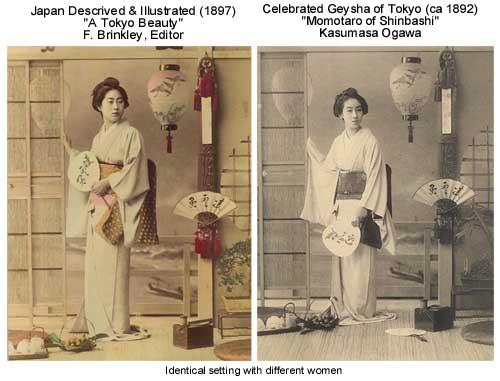
The problem with attributing the photographs to a particular photographer is the lack of credits on the photographs or in the books.
- Text Illustrations. The text illustrations in the standard format editions (black and white halftone printed directly on the page) and those in the deluxe edition formats (tipped in colored albumen photographs) are not the same. Basically, a different set of the 200+ in text illustrations was used in the two formats. Since neither set of text illustrations actually depicted the associated text, it really does seem to matter. It my opinion, they were pretty much added at random to enhance the visual appearance of the books.
- American Color Illustrated Book. Technically speaking, these books are often classified as an "19th century American color illustrated" books. While the collotypes and hand colored albumen photographs were imported from Japan, the books were printed, assembled and distributed in the United States.
- Illustrated Discussions of Various Sets on this site.
- 10 Volume "Edition De Luxe" deluxe type edition is here.
- 10 Volume "Yedo" standard type edition is here.
- 15 Section card stock cover set is here.
- Composite view of full page collotypes and albumen photographs in the standard and deluxe sets here.
- Individual K. Ogawa color flower collotypes marketed by Millet Co. here.
- Related Pictorial Arts Set Published in 1901/2.
- The Art of Japan, Pictorial Art, Volume 1, Deluxe Edition here.
|
